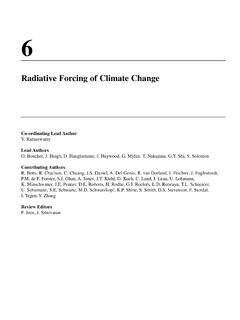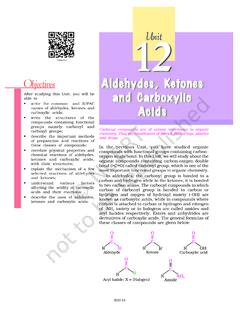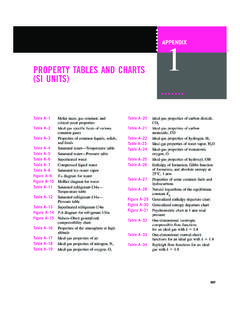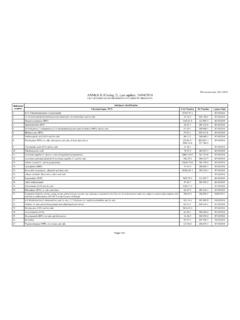Transcription of 13.5 Industrial Flares - US EPA
1 Industrial GeneralFlaring is a high-temperature oxidation process used to burn combustible components, mostlyhydrocarbons, of waste gases from Industrial operations. Natural gas, propane, ethylene, propylene,butadiene and butane constitute over 95 percent of the waste gases flared. In combustion, gaseoushydrocarbons react with atmospheric oxygen to form carbon dioxide (CO2) and water. In some wastegases, carbon monoxide (CO) is the major combustible component. Presented below, as an example,is the combustion reaction of +5O2>3CO2+4H2 ODuring a combustion reaction, several intermediate products are formed, and eventually, mostare converted to CO2and water.
2 Some quantities of stable intermediate products such as carbonmonoxide, hydrogen, and hydrocarbons will escape as are used extensively to dispose of (1) purged and wasted products from refineries,(2) unrecoverable gases emerging with oil from oil wells, (3) vented gases from blast furnaces,(4) unused gases from coke ovens, and (5) gaseous wastes from chemical industries. Gases flaredfrom refineries, petroleum production, chemical industries, and to some extent, from coke ovens, arecomposed largely of low molecular weight hydrocarbons with high heating value.
3 Blast furnace flaregases are largely of inert species and CO, with low heating value. Flares are also used for burningwaste gases generated by sewage digesters, coal gasification, rocket engine testing, nuclear powerplants with sodium/water heat exchangers, heavy water plants, and ammonia fertilizer are two types of Flares , elevated and ground Flares . Elevated Flares , the more commontype, have larger capacities than ground Flares . In elevated Flares , a waste gas stream is fed through astack anywhere from 10 to over 100 meters tall and is combusted at the tip of the stack.
4 The flame isexposed to atmospheric disturbances such as wind and precipitation. In ground Flares , combustiontakes place at ground level. Ground Flares vary in complexity, and they may consist either ofconventional flare burners discharging horizontally with no enclosures or of multiple burners inrefractory-lined steel typical flare system consists of (1) a gas collection header and piping for collecting gasesfrom processing units, (2) a knockout drum (disentrainment drum) to remove and store condensablesand entrained liquids, (3) a proprietary seal, water seal, or purge gas supply to prevent flash-back,(4)
5 A single- or multiple-burner unit and a flare stack, (5) gas pilots and an ignitor to ignite the mixtureof waste gas and air, and, if required, (6) a provision for external momentum force (steam injection orforced air) for smokeless flaring. Natural gas, fuel gas, inert gas, or nitrogen can be used as purgegas. Figure is a diagram of a typical steam-assisted elevated smokeless flare combustion requires sufficient combustion air and proper mixing of air and wastegas. Smoking may result from combustion, depending upon waste gas components and the quantityand distribution of combustion air.
6 Waste gases containing methane, hydrogen, CO, and ammoniausually burn without smoke. Waste gases containing heavy hydrocarbons such as paraffins abovemethane, olefins, and aromatics, cause smoke. An external momentum force, such as steam injectionor blowing air, is used for efficient air/waste gas mixing and turbulence, which promotes smokeless9/91(Reformatted 1/95)Miscellaneous of heavy hydrocarbon waste gas. Other external forces may be used for this purpose, includingFigure Diagram of a typical steam-assisted smokeless elevated spray, high velocity vortex action, or natural gas.
7 External momentum force is rarely required inground injection is accomplished either by nozzles on an external ring around the top of theflare tip or by a single nozzle located concentrically within the tip. At installations where waste gasflow varies, both are used. The internal nozzle provides steam at low waste gas flow rates, and theexternal jets are used with large waste gas flow rates. Several other special-purpose flare tips arecommercially available, one of which is for injecting both steam and air.
8 Typical steam usage ratiovaries from 7:1 to 2:1, by gases to be flared must have a fuel value of at least 7500 to 9300 kilojoules per cubicmeter kJ/m3(200 to 250 British thermal units per cubic foot [Btu/ft3]) for complete combustion;otherwise fuel must be added. Flares providing supplemental fuel to waste gas are known as fired, orendothermic, Flares . In some cases, even flaring waste gases having the necessary heat contentwill also require supplemental heat. If fuel-bound nitrogen is present, flaring ammonia with a heatingvalue of 13,600 kJ/m3(365 Btu/ft3) will require higher heat to minimize nitrogen oxides (NOx) many locations, Flares normally used to dispose of low-volume continuous emissions aredesigned to handle large quantities of waste gases that may be intermittently generated during plantemergencies.
9 Flare gas volumes can vary from a few cubic meters per hour during regular operationsup to several thousand cubic meters per hour during major upsets. Flow rates at a refinery could FACTORS(Reformatted 1/95)9/91from 45 to 90 kilograms per hour (kg/hr) (100 - 200 pounds per hour [lb/hr]) for relief valve leakagebut could reach a full plant emergency rate of 700 megagrams per hour (Mg/hr) (750 tons/hr). Normalprocess blowdowns may release 450 to 900 kg/hr (1000 - 2000 lb/hr), and unit maintenance or minorfailures may release 25 to 35 Mg/hr (27 - 39 tons/hr).
10 A 40 molecular weight gas typically cubic nanometers per second (nm3/s) (25 standard cubic feet per minute [scfm]) may rise to ashigh as 115 nm3/s (241,000 scfm). The required flare turndown ratio for this typical case is over15,000 to flare systems have 2 Flares , in parallel or in series. In the former, 1 flare can be shutdown for maintenance while the other serves the system. In systems of Flares in series, 1 flare, usuallya low-level ground flare, is intended to handle regular gas volumes, and the other, an elevated flare, tohandle excess gas flows from EmissionsNoise and heat are the most apparent undesirable effects of flare operation.
















